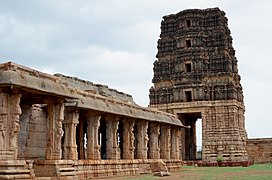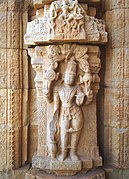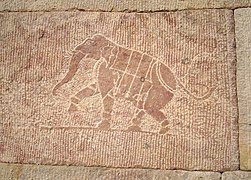
Pattadakal, also called Raktapura, is a complex of 7th and 8th century CE Hindu and Jain temples in northern Karnataka (India). Located on the west bank of the Malaprabha River in Bagalakote district, this UNESCO World Heritage Site is 14 miles (23 km) from Badami and about 6 miles (9.7 km) from Aihole, both of which are historically significant centres of Chalukya monuments. The monument is a protected site under Indian law and is managed by the Archaeological Survey of India (ASI).

The Dilwara Temples or Delvada Temples are a group of Śvētāmbara Jain temples located about 2+1⁄2 kilometres from the Mount Abu settlement in Sirohi District, Rajasthan's only hill station. The earliest were built by Bhima-1 and supposedly designed or at least financed by Vastupala, Jain minister of Dholka. They date between the 11th and 16th centuries, forming some of the most famous monuments in the style of Māru-Gurjara architecture, famous for their use of a very pure white marble and intricate marble carvings. They are managed by Seth Shri Kalyanji Anandji Pedhi, Sirohi and are a pilgrimage place for Jains, and a significant general tourist attraction. Although Jains built many temples at other places in Rajasthan, the Dilwara temples are believed to be the most impressive.

The Chennakesava Temple, also referred to as Chennakeshava Temple and Keshava Temple, is a Vaishnava Hindu temple on the banks of River Kaveri at Somanathapura, Karnataka, India. The temple was consecrated in 1258 CE by Somanatha Dandanayaka, a general of the Hoysala King Narasimha III. It is located 38 kilometres (24 mi) east of Mysuru city.

Aihole, also referred to as Aivalli, Ahivolal or Aryapura, is a historic site of ancient and medieval era Buddhist, Hindu and Jain monuments in Karnataka, India that dates from the sixth century through the twelfth century CE. Most of the surviving monuments at the site date from the 7th to 10th centuries. Located around an eponymous small village surrounded by farmlands and sandstone hills, Aihole is a major archaeological site featuring over one hundred and twenty stone and cave temples spread along the Malaprabha river valley, in Bagalakote district. Hunagunda Taluk Distance 35 km

Sri Ranganathaswamy Temple is a Hindu temple dedicated to Ranganatha, located in Srirangam, Tiruchirapalli, Tamil Nadu, India. Constructed in the Hindu architectural style, the temple is glorified by Alvars in their Naalayira Divya Prabhandam and has the unique distinction of being the foremost among the 108 Divya Desams dedicated to the god Vishnu.

Sittanavasal Cave is a 2nd-century Tamil Śramaṇa complex of caves in Sittanavasal village in Pudukottai district of Tamil Nadu, India. Its name is a distorted form of Sit-tan-na-va-yil, a Tamil word which means "the abode of great saints".

Gajalakshmi, also spelt as Gajalaxmi, is one of the most significant Ashtalakshmi aspects of the Hindu goddess of prosperity, Lakshmi.
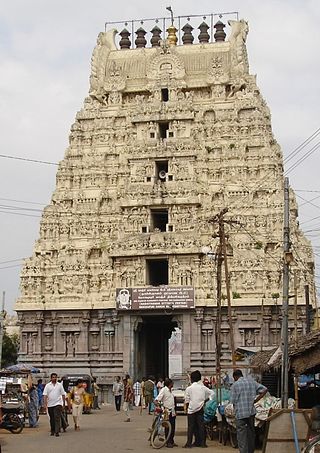
The Kamatchi Amman Temple is an ancient Hindu Temple dedicated to the goddess Kamakshi, one of the highest aspects of Adi Shakti in Shaktism. It is located in the historic city of Kanchipuram, near Chennai, India. Its construction is credited to the Pallava kings, whose capital was in the same city. This temple, along with the Meenakshi Temple in Madurai and the Akilandeswari temple in Thiruvanaikaval near Tiruchirappalli are the important centers of Goddess worship in the state of Tamil Nadu.The present temple with goddess seated in padmasana was once known as Kaamakotta Nayaki shrine, where Lalitha Tripura Sundari has settled in this temple after the destruction of the demon called Bhandasura. This ancient temple got mentioned in Perunaraatrupadai, an ancient Tamil sangam literature which praises the renowned sangam era king Thondaiman Ilanthiraiyan who ruled whole Thondai mandalam during sangam era with Kanchipuram as capital city. The original golden statue was seen with two hands adorning a parrot in her right hand is called as Bhangaru Kamakshi was replaced with the current panchaloha idol to avoid ruins of invasion. Now the golden goddess is residing in the West masi veedhi of Tanjavore with aseparate shrine, as escorted by Shyama Shastri.

Thillai Nataraja Temple, also referred as the Chidambaram Nataraja Temple, is a Hindu temple dedicated to Nataraja, the form of Shiva as the lord of dance. This temple is located in Chidambaram, Tamil Nadu, India. This temple has ancient roots and a Shiva shrine existed at the site when the town was known as Thillai. Chidambaram, the name of the city literally means "stage of consciousness". The temple architecture symbolizes the connection between the arts and spirituality, creative activity and the divine. The temple wall carvings display all the 108 karanas from the Natya Shastra by Bharata Muni, and these postures form a foundation of Bharatanatyam, an Indian classical dance.

Chennakeshava Temple, also referred to as Keshava, Kesava or Vijayanarayana Temple of Belur, is a 12th-century Hindu temple in, Hassan district of Karnataka state, India. It was commissioned by King Vishnuvardhana in 1117 CE, on the banks of the Yagachi River in Belur also called Velapura, an early Hoysala Empire capital. The temple was built over three generations and took 103 years to finish. It was repeatedly damaged and plundered during wars, repeatedly rebuilt and repaired over its history. It is 35 km from Hassan city and about 220 km from Bengaluru.

A mandapa or mantapa is a pillared hall or pavilion for public rituals in Indian architecture, especially featured in Hindu temple architecture.
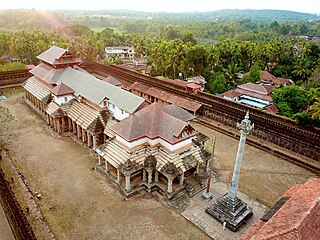
Saavira Kambada Temple or Tribhuvana Tilaka Cūḍāmaṇi), is a basadi or Jain temple noted for its 1000 pillars in Moodabidri, Karnataka, India. The temple is also known as "Chandranatha Temple" since it honours the tirthankara Chandraprabha, whose eight-foot idol is worshipped in the shrine.

The Ishvara temple, also referred to as the Ishwara or Isvara temple, is an early 13th-century Hindu temple in Arsikere, Hassan district, Karnataka India. Dedicated to Shiva, it is one of the most notable early Hoysala architecture examples with a rotating circular plan, a domed mandapa with 16-point star shape, a pancatala vimana, and a galaxy of artwork depicting Shaivism, Vaishnavism, Shaktism and Vedic legends of Hinduism.

The Kasivisvesvara temple, also referred to as the Kavatalesvara, Kashivishveshvara or Kashi Vishvanatha temple of Lakkundi is located in the Gadag district of Karnataka state, India. It is about 12 kilometres (7.5 mi) from Gadag city, between Hampi and Goa. The Kasivisvesvara temple is one of the best illustrations of fully developed Kalyana Chalukya style of Hindu architecture.
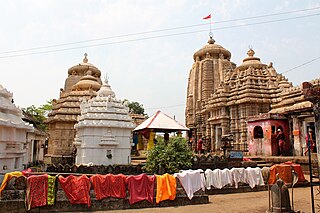
The Kapilesvara temple is a Hindu temple dedicated to Shiva located in the south western outskirt of the village Kapilesvara, Old Town, Bhubaneswar, Odisha, India. It is located at the end of Kapilesvara road leading from Lingaraj temple to Kapilesvara Village. The presiding deity is a Siva-lingam at the center of a circular yonipitha inside the sanctum. It is a living temple, facing towards east and maintained by Kapilesvara Temple Trust Board. The temple is situated within the precinct along with 33 other monuments. The precinct is located on the northern embankment of Manikarnika tank over an area of 44.00 square metres.
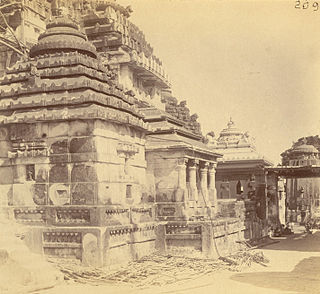
The Vimala Temple or Bimala Temple is a Hindu temple dedicated to goddess Vimala or Bimala (ବିମଳା), located within the Jagannath Temple complex in Puri in the Indian state of Odisha. It is generally regarded as a Shakti Pitha, among the holiest temples dedicated to the Hindu Goddess.
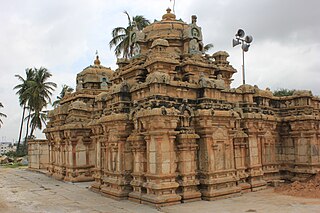
The Nageshvara temple complex is located in Begur, a small town within the Bangalore urban district of Karnataka state, India. From inscriptions, it is known that Begur was once called Veppur, and Kelele. Two shrines within the temple complex, the Nageshvara and Nageshvarasvami were commissioned during the rule of Western Ganga Dynasty Kings Nitimarga I and Ereyappa Nitimarga II. The remaining shrines are considered a later day legacy of the rule of the Chola Dynasty over the region. An Old Kannada inscription, dated c. 890, that describes a "Bengaluru war" was discovered in this temple complex by the epigraphist R. Narasimhachar. The inscription is recorded in "Epigraphia Carnatica". This is the earliest evidence of the existence of a place called Bengaluru.

Mamandur is a village in Tiruvanamalai district of Tamil Nadu, India. It is located on the Kanchipuram - Vandavasi road, near Dusi and about 15 km from Kanchipuram. It is known for the 7th-century rock-cut cave temple, housing a Tamil Brahmi inscription, one of the monuments of national importance as declared by the Archaeological Survey of India.
Manwal is a town in Udhampur district of the Jammu division of Jammu and Kashmir, India. It lies 28 km (17 mi) away from the district headquarters of Udhampur.

Sri Ramakrishna Math, Lucknow is a monastic organisation for men created by Ramakrishna (1836–1886), a 19th-century saint of Bengal. The motto of the Ramakrishna Math and Ramakrishna Mission is: "For one's own salvation, and for the welfare of the world". It contains idols of Ramakrishna, Swami Vivekananda and Holy Mother Sarada Devi.






